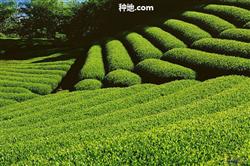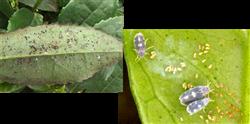adult garden Learn more about adult garden
-
Cultivation methods of adult tea garden

Cultivation methods of adult tea garden
2018-07-11 -
What are the diseases and insect pests of tea?

What should be noticed in the process of tea cultivation? Please point out the following tea cultivation methods for your reference: 1, nursery and young tea garden field management timely clean up the nursery and young tea garden stones and other debris, remove stagnant water, straighten the tea seedlings, cut the injured young tea seedlings at the injured site with scissors; count as soon as possible.
2018-07-18 -
What are the garden plant piercing pests? How to control piercing and sucking pests?

Piercing and sucking pests are very common in garden plants. The individuals of these pests are small but the number is very large, and the initial symptoms of plant damage are not obvious, so people tend to ignore them. What are the common piercing and sucking pests? How to prevent and cure
2018-10-15 -
What are the common borer pests in garden plants? How to integrate prevention and control?

Garden plants are easily harmed by borer pests in daily life, which are hidden, harmful and difficult to control, which bring some difficulties to garden plant protection. The following editor will introduce the common borer pests and their control methods.
2018-10-16 -
Technical plan for prevention and control of main tea diseases and insect pests in 2019

The main diseases and insect pests in tea gardens in China are tea small green leafhopper (small green leafhopper), black whitefly, gray tea inchworm, tea inchworm, tea caterpillar, tea orange gall mite, coffee claw mite, horned breast beetle, tea net bug, tea black poison moth, tea yellow thrips, tea stick thrips and tea stick thrips.
2020-11-09 In 2019 tea trees major diseases and insect pests prevention and control technology programs national -
Oriental beetle

Oriental beetle, also known as black velvet Gill beetle, velvet beetle. It belongs to the family Coleoptera. It is widely distributed and has miscellaneous feeding habits. Both adults and larvae can cause harm and can harm more than 100 species of plants. Adults are addicted to poplar, willow, cherry blossom, magnolia, magnolia, Koeluan tree, sycamore, peach, crape myrtle, heather and other dozens of garden plants. Morphologically, the adult is 7 to 9 mm long and 4.5 to 6 mm wide, ovoid, narrow in front and wide behind; brown at first Eclosion, and then gradually dark brown or black, body surface
2019-01-16 -
Tea wing bug and hemp skin bug

Tea-wing bugs and hemipterous bugs both belong to Hemiptera Pentatomidae, and they are also pests that do great harm to garden ornamental plants. Tea wing bug bug Halyomorphapicus alias stinky wood bugs, smelly elder sister, brown bugs host a wide range of food, harmful to Robinia pseudoacacia, elm, figs, cloves, pomegranate, paulownia, peach, begonia and other garden plants. Harmful adults and nymphs feed on tender leaves, stems and fruit juices, causing leaves to turn yellow and early.
2019-01-15 -
Control methods of small green leafhopper in organic tea garden

Control methods of small green leafhopper in organic tea garden
2018-07-25 -
How to control tea spiny whitefly?

How to control tea spiny whitefly? Please guide tea black whitefly to do obvious harm to tea buds and leaves. Generally, the nymphs of whitefly are found in the leaves of tea garden. most tea farmers do not know the adults of whitefly, and the intake of a large number of adults directly affects the quality and yield of tea production. ...
2018-07-18 -
Control methods of privet inchworm in garden ornamental trees

Distribution and damage of privet inchworm NaxaseriariaMotschulsky, also known as lilac inchworm. It belongs to Lepidoptera, Geometridae. Distributed in Northeast, North China, Northwest, Southwest and East China. The larvae are martyr, Beijing clove, weeping clove, lilac, Liaodong clove, white clove, privet, big leaf privet, sweet-scented osmanthus, camellia, tea, water wax, Fraxinus mandshurica and Fraxinus mandshurica. The larvae gather to feed on the leaves, often nibbling away at the leaves. The larvae have the habit of spinning and netting, and when it is serious, the net covers the tree crown.
2019-01-16 -
Identification and control of tea inchworm

Inchworm, commonly known as foot worms, is an insect of the family Lepidoptera and Geometridae. There are many kinds of inchworm in the tea garden, mainly including paulownia inchworm, silver inchworm, gray inchworm and Camellia oleifera inchworm. Among them, paulownia inchworm occurs most frequently, and it is also called big inchworm, which is the largest type of inchworm occurring in the tea garden. it harms the larvae, eats a lot of food and hosts, and in serious cases, eats all the buds of the tea garden to form a smooth rod. The adult worm is silvery gray, with a body length of 20ml 25mm and a wingspan of 50mi 70mm. The wing surface is densely covered with black dots, and the forewing has three distinct yellow strips.
2019-01-11 -
Japanese turtle wax of yellow poplar

It occurs one generation a year, overwintering with fertilized female adults on shoots. Morphological features: female adult, wax shell gray or slightly fleshy red, oval. Male adult with a dark brown or brown body and a deep dorsal plate of the head and chest. Nymph, wax shell oval to oval, back slightly raised. Prevention and control methods: (1) Quarantine measures: when purchasing seedlings in different places, plant quarantine procedures must be strictly carried out to prevent the artificial spread of pests. (2) strengthening garden maintenance and management: through maintenance and management, to create environmental conditions that are not suitable for the survival of shell insects. Carry out rotation planting and clear the garden in time
2019-01-16 -
Control wood lice in winter and produce good pears in autumn

Pear planthopper is the most important pest on pear trees. It can harm pear leaves, cause withered spots, weaken the tree, and reduce fruit quality and yield. Four and five generations occur every year. There are two types of adults: winter type and summer type. The winter-type adults overwintered in the cracks in the branches of pear trees, and a few in weeds, fallen leaves and soil. Comprehensive prevention and control should be carried out for its overwintering places. 1. Clear the garden. Clean up the residual branches, fallen leaves and weeds in and around the garden, bury or burn deeply, and reduce the number of overwintering pear wood lice. 2. Shave. Spread plastic film on the tree plate
2019-01-16 -
Late-stage Management techniques of Adult Zanthoxylum bungeanum Garden

First, strengthen the management of flowering and fruiting stage ⑴ boron spraying during flowering period: spray 0.3% borax solution 1-2 times during flowering period, the fruit setting rate can be significantly increased. ⑵ uses Zanthoxylum bungeanum red accelerant: the use of red accelerant can promote pepper coloring and increase yield. 7-10 days before picking, 200-fold solution of red accelerant was sprayed on the tree for 1-2 times, so that the mature period of Chinese pepper was relatively concentrated, the picking efficiency was increased by more than 2 times, and the pepper skin was bright, the peeling rate increased by 3.3%, and the plant yield increased by 23%. ⑶ timely
2019-01-15 -
Management of tea tree crown

1. Tea pruning is an important measure in crown management. Pruning includes stereotyped pruning in infancy, light and deep pruning in adult tea gardens, re-pruning and table cutting in aging tea gardens. The main results are as follows: (1) stereotyped pruning of young tea trees: 3 or 4 times of stereotyped pruning in young tea trees can inhibit the apical dominance of the trunk of young tea trees, promote the germination of axillary buds, increase the number of backbone branches, and quickly form a robust picking surface with a certain height. The first stereotyped pruning of ① was carried out after the cuttings were transplanted. When the transplanted seedlings are as high as 25cm
2019-01-16 -
Causes of outbreak of tea inchworm and its pollution-free control

Tea inchworm, also known as Archworm, measure-inch worm, hanging filariasis, belongs to the family Lepidoptera. The pest is mainly distributed in Bihu, Lixin and other tea areas in Liandu District. It is a kind of overeating pest. If the prevention and control is not in time, the output of summer and autumn tea will be seriously reduced, and the tree potential will decline, which will seriously affect the tea production. It happened every year in the past few years, but it didn't do much harm. In August 2007, the insect occurred in a large area in the tea garden in Huangling, Lixin Township, which not only seriously affected the tea yield in that season, but also caused tree potential decline and poor cold tolerance.
2019-01-15 -
Control methods of Populus tomentosa in ornamental trees in Garden

Distribution and damage of Populus tomentosa PryeriasinicaMoore, also known as Populus tomentosa and Euonymus holly. It belongs to Lepidoptera, Lepidoptera. Distributed in Shanghai, Nanjing, Wuxi, Suzhou, Hangzhou, Wuhan, Lianyungang and Hefei. Damage to Euonymus tomentosa, Euonymus tomentosa, Golden Heart holly spear, Dahuawei spear, Fufang vine and silk cotton wood and so on. The larvae feed on the host leaves, and when the occurrence is serious, the leaves are eaten light, which affects the normal growth of plants. Morphological characteristics of adults oblate, black back, chest back
2019-01-16 -
Field management of growing figs

The main results are as follows: (1) Intertillage weeding: the young garden should carry out intertillage weeding once in spring, summer and winter, and combine intertillage with soil cultivation to prevent freezing in winter. The adult garden is ploughed during dormancy and covered with grass in summer, which can not only inhibit the growth of weeds, but also prevent drought and preserve soil moisture. If there are still weeds,
2020-11-08 Species figs field management ploughing weeding juvenile gardens -
Planthopper is the only vector of Huanglong disease how to control planthopper on citrus

Planthopper is the only vector of Huanglong disease how to control planthopper on citrus
2018-07-14 -
Occurrence characteristics and control techniques of black whitefly in tea plant

The black thorn whitefly mainly uses the larvae to absorb the tea tree juice on the back of the leaves, which causes coal bacteria parasitism and coal disease, and when it is serious, the tea tree is pitch black. The damaged tea trees had lower photosynthetic efficiency, lower germination density, late germination, thin bud leaves and serious defoliation, which not only affected the yield and quality of tea, but also seriously affected the potential of tea trees. 1. The occurrence characteristics of the insect occur for four generations a year, overwintering as mature larvae on the back of tea leaves, pupating in March in the second year, and the peak periods of the first to fourth generation larvae are in late May, mid-July, late August and September, respectively.
2019-01-16
